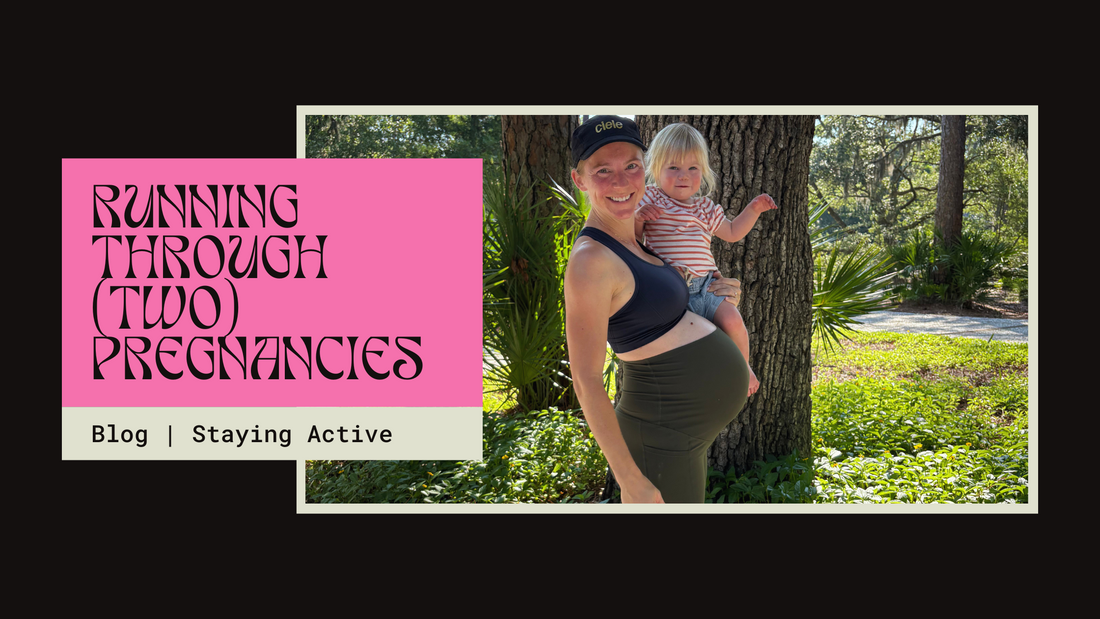
Running Through (Two!) Pregnancies
Share
By Natalie Narburgh
I’ve always been active. Rock climbing, mountain biking, workout classes—I love it all. But the activity I’ve stuck with most consistently since high school is running. It started with road runs with a friend, which turned into half marathons in college. When I moved to Colorado, I absolutely fell in love with trail running. Since then, I’ve gone through phases where each “kind” of run has felt like my favorite. Whether it’s long self-supported adventures like the Presidential Traverse in the White Mountains, an organized 10K on a scenic road, or a gentle jog to catch up with friends on my hometown trails—I’ve learned over the years to appreciate all types of runs.
That said, trail running in particular gives me a special kind of fulfillment. It’s like elevating my heart rate in the woods brings a unique sense of peace—a feeling of strength and simultaneous release. So when I first got pregnant, I found myself wondering: What will running feel like when I’m pregnant? Are you even SUPPOSED to run when you’re pregnant? (Spoiler alert—you can totally continue running while you’re pregnant!)
In the end, pregnancy and postpartum have challenged my entire concept of what it means to be active. Now, at 33 weeks along with my second baby (our kiddos will be 22 months apart!), I'm grateful to have just finished my last run of this pregnancy—even if it’s felt different. I hope that by sharing my running story, other new mammas and mammas-to-be can feel motivated to keep getting after it themselves.

Here are some of the key lessons I’ve learned along the way:
1. Be Gentle With Yourself.
Your pace is going to change—maybe even from day one. In the first trimester, I often felt like a sack of rocks being lugged up a hill. The exhaustion that hits during pregnancy is intense, and running brings it out like no other. Your body is producing more blood, your baby is demanding more oxygen, and you're literally growing a brand-new organ before your bump even shows. THAT’S WILD. Recognize your body is doing incredible things, and that will affect your pace, form, and energy levels.
Some days, especially in the first trimester, a two-mile jog (at a pace some might call “fast hiking”) has felt like a marathon for me. That’s expected—because I’m expecting! I treat it as such and have taken time to rest. Other days I’ve surprised myself and run twice as far as I thought I could. Either way, I’ve learned to listen to my body and rest without guilt.
2. Celebrate Your Wins (and track them if you’re a nerd).
I’m a nerd, so I made a Google Sheet to track my workouts. I call it “Powerful Pregnancy,” because let’s call it what it is! Honestly, I made the spreadsheet because I was struggling to accept my slower pace of life and was feeling like I was losing my active identity. But once I started logging my workouts during my first pregnancy, I realized I was still being incredibly active—just in different ways. One day might be a 30-minute walk. Another might be a five-mile jog. But seeing those activities laid out consistently throughout the week helped me feel grounded in my identity again.
Tracking also helped me stay accountable to my goal of continuing to run as long as my body felt able. More importantly, it reminded me that movement is movement, no matter how fast or far.

3. Every Pregnancy and Accompanying Discomfort Is Different.
AKA, don’t compare yourself to what you think you should be able to do. During my first pregnancy, I felt surprisingly good while running through the first two trimesters. Sure, I had days I probably pushed too hard and had to scale back, but it wasn’t until the third trimester that pelvic pain and “lightning crotch” crept in. When those sensations showed up mid-run, I would stop and walk. Sometimes I’d pick the pace back up; other times I wouldn’t. By week 30, I had transitioned to more hikes and walks, and I took my final pregnancy run in week 35.
This second time around has felt totally different. More aches, more fatigue, fewer runs overall, and a slower pace. And that’s okay. Having a toddler obviously changes things, but so does your body’s individual response to each pregnancy. Some discomforts that showed up late in my first pregnancy arrived early in this one. That unpredictability has been humbling—but also empowering. It reminded me of lesson #1: Be gentle with yourself. My expectations have needed to shift, but that doesn’t mean I’m any less strong. I like reminding myself that I’m growing another human being while continuing to demonstrate my own body’s strength. Whether it’s one mile or ten, it’s pretty darn cool.
4. Stay Cautious.
It probably goes without saying, but hydration is key. I drink tons of water, take daily electrolytes, and avoid running in the heat of the day. Surface matters too. I love trails, but as my belly grew, I knew my confidence in safely navigating roots and rocks was diminishing. I gradually shifted to road and gravel runs and got my “trail fix” on hikes instead. Everyone’s comfort level and risk tolerance is unique during pregnancy, so do what feels appropriate for you.
Lastly, one game-changer was using a belly band. On a recommendation from my PT, I started using one during runs and workouts—it’s helped support my bump and made my Braxton Hicks contractions slightly less frequent.

5. Be Ready to Stop and Pee. A lot.
6. Stop When You Feel Like You Should Stop.
A lot of folks asked me, “How long will you keep running for?” and I never knew the answer. Your body will give you cues on what it’s capable of at that point in pregnancy, and you just have to trust in it. During my first pregnancy, I stayed consistent all the way through to when I called my last run. In my second, I took a few weeks off because it wasn’t feeling right. I eased back in after doing some strength training and was able to keep it up for another few months. Listen to your body, and you’ll know when to throw in the towel.
Pregnancy may reshape your relationship with movement, but it doesn’t have to erase it. Your pace, your route, and your expectations may change—but your identity as an active, strong, adventure-loving human doesn’t have to. Whether you're logging slow walks or celebrating a two-mile jog like it’s a marathon, you’re still a badass.
